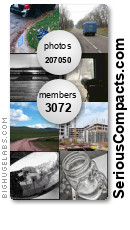In The Field
The next afternoon I hiked into the forest with my tripod, Hasselblad H2 and P45+ with the Hasselblad 55-110mm lens attached, and photographed a lovely deep forest fall scene. As I stood there wondering where to go next I put my hands in my vest pocket (it was a chilly fall morning), and there was the Canon G10.
Humm! I wonder how the it would compare with the H2/P45+ combo in a critically controlled side-by-side comparison. Nahh! Silly idea.
But – nothing ventured, etc, and so without a tripod mount for the G10 I simply held it firmly braced on top of the Hassy and did an exposure, framing the shot as closely as I could to what I'd done on the Hasselblad.
Read on at The Luminous Landscape - You've Got to be Kidding!
If that article makes you want a G10, good timing. Amazon has them in stock and just dropped the price to $482 shipped.
Featured Comment by Walter K:
Michael Reichmann generally provides valuable information on his site, particularly when it comes to real field testing of DSLRs and Medium Format equipment, a service that most other review sites don't provide. His occasional forays into the realm of better quality compact digital cameras can be useful too. But not this time.
Michael Reichmann's recent experiment with Canon's G10 got my attention: “Could a $500 digicam equal a $40,000 medium format digital system in image quality, at least in prints up to 13X19" (Super A3)?" The answer, he seems to be saying, is yes, proclaiming that the "G10 has crossed a threshold". But after evaluating the full res files from the G10 and Phase One P45+ Back it's difficult to know exactly what threshold the G10 has crossed. The subject matter and conditions in which the test was conducted could not be more ill suited to comparing these two cameras.
When I first looked at the medium format image file at 100% I was taken aback at how much of the scene was out of focus due to shallow depth of field. The 1 second exposure further contributed to an overall softness of the scene as leaves are clearly being blown around by the wind. By contrast, as Reichmann admits, the G10 file has an overall crispness due to the shorter focal length lens and shorter shutter speed of 1/8 of a second (and what looks to me like over–sharpening). The medium format is thus at a distinct disadvantage, especially if one is expected to evaluate resolution and acutance in a super A3 print. Yet, in a ploy to dramatize the G10 underdog status in the story Reichmann states: "Overall if there was any technical bias in the test it was in favor of the medium format system".
Furthermore, there are additional problems related to the character of surface textures in the test scene. Noise is prominent in the G10 file, but the texture of tree bark and ground cover (the few areas of the scene that are reliably sharp) would most certainly act to camouflage adverse effects of noise artifacts in prints, further equalizing the apparent quality of the two cameras.
It would have been far more informative to readers to approach the experiment by showing both cameras performing optimally in the field, even if limiting the test to super A3 size print. Only then do you get to draw a conclusion (and a limited one at that) about the image quality between $500 camera and $40,000 system.
You can’t excuse a poorly conducted test by calling it “informal”. It’s still a poorly conducted test and few conclusions of any value can be drawn. The whole enterprise, accompanied as it is with so many caveats, yet so positive in its “threshold” crossing proclamations, only serves to undermine the credibility of the author and call in to questions his analytical skills.
Walter K

